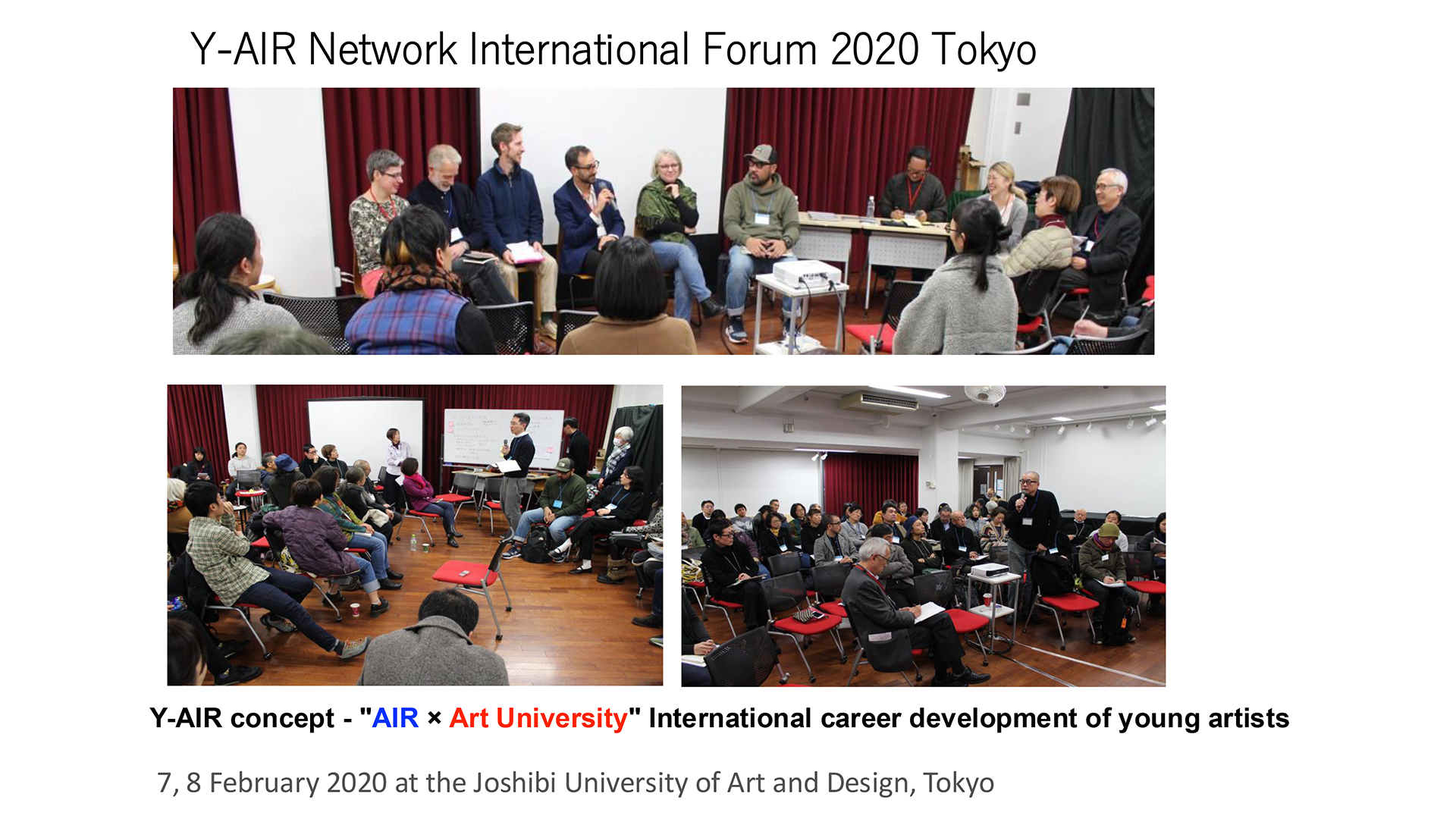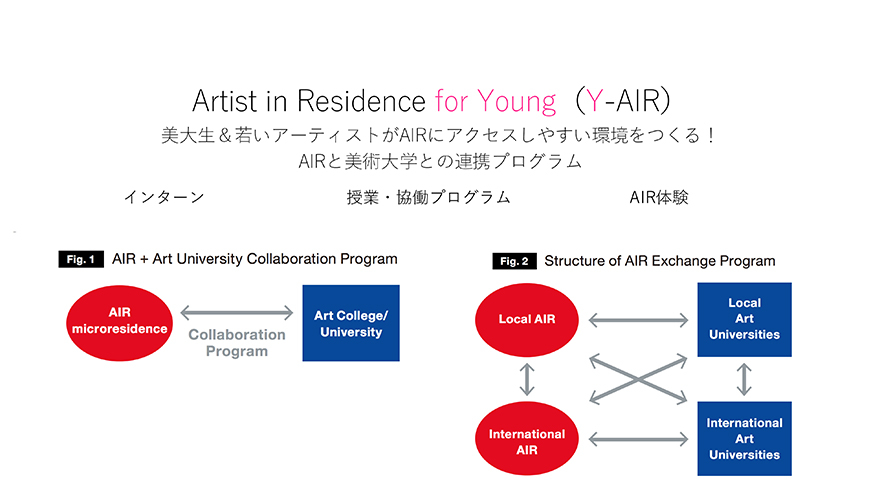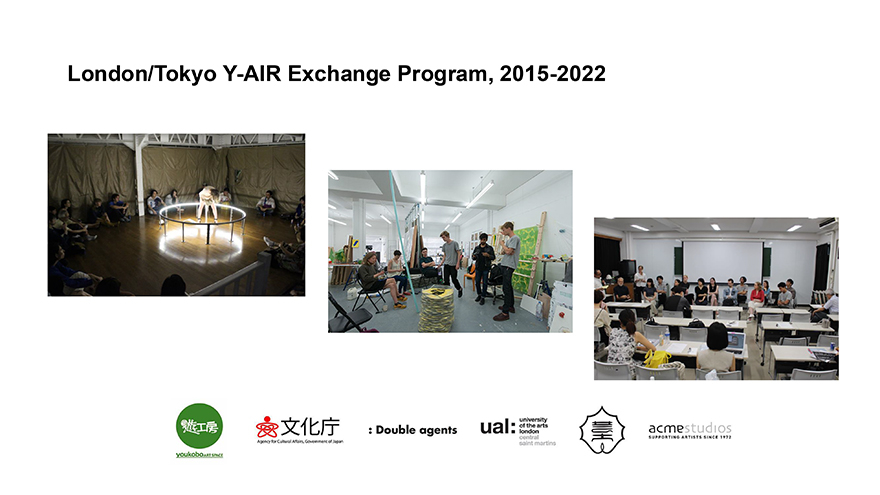What is AIR (Artist-in-Residence)? (5): the last
Residency network (2)—Putting Y-AIR into practice and the start of an international network
By Murata Tatsuhiko

Over the last four articles, in an effort to answer my own question, “What is AIR (Artist-in-Residence)?” I have discussed the Youkobo Art Space and Artist-in-Residence Program, an artist-led residency that grew out of my own experience as an AIR operator.
Here, I would like to say a word about the artists themselves who experience staying at AIR facilities. I recall two interesting English expressions concerning artists: “living artist” (an artist who is alive today and continues to create work) and “starving artist” (an artist who is hungry in terms of both living and opportunities). In addition to these two terms, there are other names for artists, including “well-known artist,” “emerging artist,” full-time artist” and “working artist.” This commentary on the situation in the U.S. is still fresh in my mind.[*1]
In this final article, I would like to conclude by discussing our own practical activities with respect to “Y-AIR, AIR for Young,” which is directed at “young artists” who do not fit into any of the above categories. At the same time, in the interests of impartiality, I would also like to touch on the management of AIR as creative hubs for artists.
Once during a discussion about AIR, in response to questions around why there is no Japanese term that corresponds to “AIR” and why it is not translated into Japanese, someone suggested “旅先造り” (tabisaki-tsukuri, lit. “making [work] during a journey”). [*2] In Chinese, apparently the characters “藝術家進駐” (lit. “artist[s] in residence”) are used.
Based on the maxim that one should travel while one is still young and on the realities concerning the diversity of AIR and the sources of funds for activities, and referencing the experiences of the artists who are the users of AIR and stories about the struggles of AIR operators, I have discussed with fellow AIR operators in Japan and overseas and teachers at art universities and other institutions from both these standpoints the kinds of artists that need support and the kinds of AIR that are needed. As the heart of tabisaki-zukuri, we considered the necessity of creative hubs for young artists and the role of AIR as entities to serve this function. Not only for art students aspiring to become artists, but for all artists who are still lacking creative experience, escaping academia and “making work during a journey” is probably a good thing. Looking into residences that operate throughout the year and where fellow artists with diverse backgrounds are engaged in activities will no doubt provide good stimulation. Today, when international exchanges are widespread, it may also be convenient for there to be mutual exchange programs as part of inter-university exchanges.
Following the “discovery of microresidencies” outlined on in my previous article, through exchanges with the OJUN lab at my partner’s alma mater, Tokyo University of the Arts, and Hinuma Keiko’s lab at Joshibi University of Art and Design, and other investigation and research activities, as well as from Youkobo’s own studies of cases in Japan and overseas, the shape of “AIR as opportunities for young artists” emerged in the form of “Cooperation Between AIR and Art Universities—A Micro and Macro Collaboration/Y-AIR Concept.” With “Y-AIR, Air for Young—‘AIR x Art University’ International career development for young artists” as the background, a viable process would emerge based on collaboration between AIR operators and art universities (although in hindsight, I don’t think this should be limited to art). Together with the creation of AIR opportunities, an internship program enabling art students to spend time at AIR, a collaborative program involving AIR and art universities, and an AIR experience program were launched as practices aimed at expanding such opportunities for experience.[*3]
[*1] Shioya Yoko, “Chapter 2 Demokurashī to puro no geijutsuka” [Democracy and professional artists], in Nyū Yōku—geijutsuka to kyōzon suru machi [New York—How the city and its artists coexist] (Maruzen, 1998).[*2] “Artist-in-Residence NOW 06: Youkobo Art Community—The Little Art Space that Could!: My Belief in the artist-in-residence activity at Youkobo Art Space” (From a conversation with Asaga Masaji, representative of the Iwase Rock Museum).
[*3] “A home for the creative activities of artists—its structure as an important vessel within society and the potentials of a network“

Following are several examples of these ideas put into practice. The “London Case” began as an attempt to focus on the creation of AIR opportunities for young artists through the cooperation of AIR operators and educational institutions based on discussions during visits by the London-based artist unit Mark Dunhill and Tamiko O’Brien, who have stayed at Youkobo a number of times since 2007, from their perspectives as artists and educators. In 2014, with the assistance of Professor OJUN, who has a wealth of AIR experience, they held a creative workshop entitled “Collaboration” involving art students from different faculties on campus (including fresh graduates). At the same time, we also launched art student internships at AIR, offering participants the valuable experience of learning how artists go about their work by supporting the creative activities of resident artists. Starting the following year, we were able to develop this into an exchange program involving art students (including graduates and those enrolled in master’s courses) in Tokyo and London, which has continued as we seek to make improvements each year it is implemented.[*4]
[*4] “Artist in residence as opportunities and places for young artists-The possibilities of Y-AIR in a trial between Tokyo and London“
The “Czech Case” is ArtCamp), a roughly one-month-long international exchange program involving participation in week-long short courses in various art techniques and interchange between different cultures held at the University of West Bohemia during the school’s summer holidays. In the program’s third year, in addition to dispatching participating young artists, we began dispatching artists who serve as Japanese instructors in campus classes as well as researchers. These ongoing activities have developed into an inter-university exchange program. Youkobo’s participation in ArtCamp resulted from an introduction by the EU-Japan Fest Japan Committee, which introduces Japanese culture in conjunction with the European Capital of Culture program, making for a unique exchange program realized through the cooperation of art university faculty in Japan that offers young artists an opportunity to stay in the Czech Republic.[*5]
The “Finnish Case,” which began later, is based on the relationship between the University of Lapland and the microresidence Waria Art Break in Finland, and Tokyo University of the Arts and Youkobo in Japan, and is a new pattern involving on the Japan side participation in the Tenku Art Festival in Tomi, Nagano, which is organized by Tokyo University of the Arts, and the use of studios at the two universities.[*6]
For more examples of Y-AIR initiatives in Japan and overseas, see the report “Case Examples of Y-AIR in Japan.”[*7]
To call attention to these efforts to put the Y-AIR concept into practice throughout Japan and overseas and promote further studies with those engaged in these efforts with the aim of developing the concept into international exchange programs, in February 2020 the first Y-AIR Network Forum was held at the Suginami Campus of JOSHIBI University of Art and Design with the special support of the university’s president, Ogura Fumiko. Although this was a difficult time when people were beginning to become concerned about the COVID-19 pandemic, we were fortunate to attract many participants from Japan and overseas including AIR operators and art university faculty.[*8]
[*5] “Artist-in-residence as opportunities and places for young artists—the possibilities of Y-AIR in a trial between Japan and ECoC 2015 Pilsen”[*6] “A collaboration between an Artist-in-Residence (AIR) and an Art University—A Y-AIR trial between Finland and Japan”
[*7] ・ “MICRORESIDENCE!2015 Case Examples of Y-AIR in Japan vol.1. Artist-in-residence as opportunities for young artists”
・ “MICRORESIDENCE!2015 Case Examples of Y-AIR vol.2. Artist-in-residence as opportunities for young artists”
[*8] “ Y-AIR Concept—‘AIR x Art University’ International career development for young artists“

The forum was an opportunity for all the participants to commit to the continuation and expansion of these activities, and I can recall as if it were a dream proceedings ending with the promise to meet again in London in 2021. We are currently exploring ways to continue the implementation of activities and to restart the exchange program network.
In bringing this series of articles to a close, I would like to acknowledge that it is thanks to the understanding and assistance of the artists, instructors, researchers, and support organizations in Japan and overseas who were actively involved at various phases that we were able to implement and continue our artistic activities over the last 50 years. In the gaps between reality and the many social contradictions that have been exposed due to the pandemic, now more than ever we are keen to push on with these activities together with young artists with the aim of creating a richly diverse society by offering real experiences of cultural exchange.
Finally, I would like to thank ICA Kyoto for giving me the opportunity to write these articles as well as the many people who have helped and supported me along the way.
- “What is AIR? (1): The origins of the Youkubo AIR program“
- “What is AIR? (2): A Sculpture Symposium“
- “What is AIR? (3): 50 years of Youkobo, 30 years of residency activities, and the Fujino annex“
- “What is AIR? (4): The discovery of microresidencies“
Tatsuhiko Murata
Having worked as an engineer for almost 30 years, together with his partner, Hiroko Murata, established their own art center as Youkobo Art Space since 1988, has worked to promote art through the running of a dynamic Artist Residency Program in Tokyo. From 2010 he initiated research into artist-run and micro-scale residency programs, so called MICRORESIDENCE, throughout the globe with an aim to increasing their recognition and also visibility appeal that the AIR program as important social vessel in the society.
Since 2015, he had been implementing Y-AIR, AIR for young (more opportunities for AIR activities to young artists!) through residency activities and collaboration with art universities. Co Director of Youkobo Art Space, Honorary board member of Res Artist.